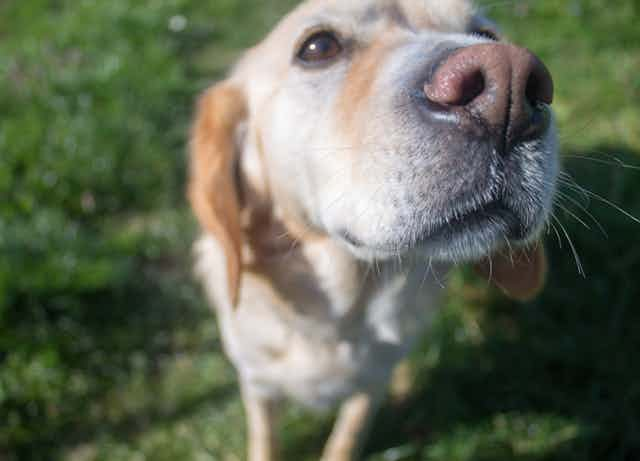The idea of cute puppy dogs playing a role in leading us out of this pandemic is about as tantalising a story anyone could conjure up right now.
It’s the type of good-news story you see at the end of the evening news bulletin involving cute animals making us healthier or happier. This time it involves using sniffer dogs to detect COVID-19.
So is there anything to this?
Read more: Your dog's nose knows no bounds – and neither does its love for you
The proposition is plausible. Dogs’ noses are amazing instruments, which is why we already use them to sniff out bombs, drugs and dead bodies.
A dog’s sense of smell is tens of thousands of times more acute than a human’s. It’s many times more sensitive than the most sensitive equipment to detect odours. Dogs can also sniff out diseases such as cancer and diabetes.
So can dogs sniff out COVID-19? Before examining the evidence, there’s no suggestion dogs would replace the PCR test, the best diagnostic test we have for COVID-19 presently.
Instead, researchers hope dogs will be used for mass screening. This might be useful for quickly picking out individuals with COVID-19 in large crowds, say at airports, sports stadiums or concerts.
How do we know if dogs are up to the job?
The best way to evaluate the performance of a test (in this case a trained dog’s nose) is to compare its results with the best test available (in this case the PCR test).
We want to know how good dogs’ noses are at correctly identifying people who:
have COVID-19 (as determined by a PCR test), a measure known as sensitivity
don’t have COVID-19 (as determined by a PCR test), a measure known as specificity.
A good screening test will have both a high sensitivity and a high specificity. If a test has a low sensitivity, it will often misclassify people as not having the disease when they do (false negatives). And if a test has a low specificity it will often misclassify people as having the disease when they don’t (false positives).
Read more: Is your dog happy? Ten common misconceptions about dog behaviour
So how about those cute doggies?
The great news is dogs seem to perform exceptionally well in screening for COVID-19. Two recent preliminary studies suggest they can do this with high sensitivity and high specificity.
One study, which has yet to be independently verified by other researchers (peer reviewed), involved training six dogs to alert their handlers when they detected the scent of COVID-19 on clothing from an infected person. This study found a sensitivity of 82-94% and a specificity of 76-92%.
A second study, which was presented at a conference and again has not been independently verified, involved training nine dogs. They identified cases from pieces of fabric that had been wiped on people’s armpits and put in a jar. This found a sensitivity of 97% and a specificity of 91%.
Taken together, it seems dogs are very good at rapidly detecting individuals with COVID-19 and don’t often get it wrong.
But hang on a minute
It’s important to temper our enthusiasm with the usual caveats:
we need to interpret all study findings cautiously until they are independently verified by other researchers (peer reviewed)
it would give us more confidence in the findings if other researchers reproduced these findings using more people
there is a big difference between dogs detecting COVID-19 in the controlled laboratory environment and the real world, which is messy, chaotic and full of other smells and distractions.
Yet, I think these results are promising enough to justify some serious tail wagging.
How does it work out in the field?
A number of countries are already looking at using dogs to screen for COVID-19 out in the real world.
But there are a few important operational limitations, the kind only revealed when you move dogs out of the laboratory. According to a Thai researcher:
5pm is their dinner time. When it’s around 4.50, they will start to be distracted. So, you can’t really have them work anymore. And we can’t have them working after dinner either because they need a nap.
These are limitations we can all relate to and shouldn’t detract from the cutest possible addition to our fight against COVID-19.

